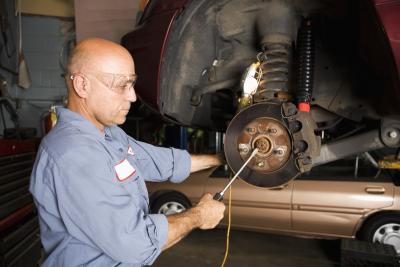
The anti-lock braking system is an electrical system that prevents your brakes from locking up during braking. Anti-lock braking systems (ABS) prevent fishtailing and other unexpected dangers when driving in bad weather conditions. When the ABS sensor comes on in the car, you may have an issue with the ABS system. Knowing how to troubleshoot the ABS sensor problem may prevent a nasty accident from a faulty ABS system. You may even find that the ABS sensor is firing without a proper issue behind it.
Inspect the brake fluid level of the car by lifting out the brake fluid dipstick and checking the level on the stick. Fill the brake fluid if necessary.
Listen for grinding noises from the brakes. This indicates a problem with the brake cylinders or pads, and not an issue with the ABS. Increased pressure needed on the brake pedal for regular braking also indicates an issue.
Turn the ignition key "On" and "Off" to turn on the car's electrical system to see if the ABS light resets. If not, further troubleshooting is needed.
Check the fuse for your ABS unit. The fuse is inside the fuse panel inside the car. Check the resistance level of the fuse and the fuse panel using a voltmeter. Set the voltmeter to the resistance setting indicated in your car manual, and check the fuse port by inserting the probes from the voltmeter into the port. Check the resistance value against the value in your manual.
Unplug the main harness for the ABS system controller, and plug it back in to reset the system. If the warning light still comes on, take your car to a professional mechanic.
Have the mechanic run an ABS controller diagnostic. This costs less than $100, and tells you where to look by giving you an error code that indicates the source of the problem.